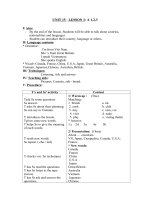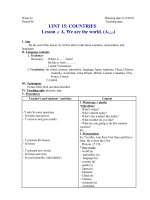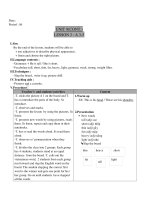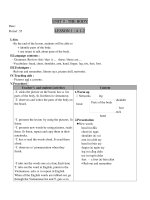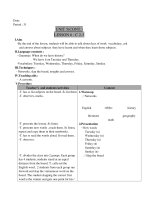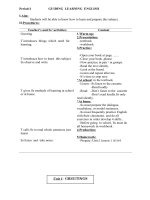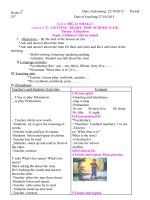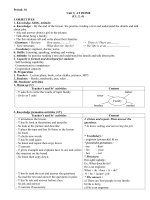tieng anh 6 sach cu
Bạn đang xem bản rút gọn của tài liệu. Xem và tải ngay bản đầy đủ của tài liệu tại đây (152.72 KB, 11 trang )
Planning date: 28/9/2016
Teaching date: 30/9/2016
4/10/2016
Total of students: 6A:……………………
6B:……………….…..
PERIOD 20:
UNIT 4: BIG OR SMALL
Lesson 1: WHERE IS YOUR SCHOOL? (A1- 2)
I. Aims:
1. Knowledge :
- To introduce the students new words and structures relating to the topic “Big or
Small”.
- By the end of the lesson, the students will be able to ask and answer a thing’s position
and characteristics and the possessive of a noun.
1.Vocabulary: school, country, city, big, small.
2. Structures: + Where is Phong’s school?
+ It is in the country/city.
+ It’s small.
2. Skills:
-Listening, Speaking, Reading & Writing skill.
3. Attitude:
4. Formation and capacity development
II. Teaching aids:
Textbook ; a posters; CD- cassette.
III. Procedure:
1. Organization: Greeting and checking attendance
2. Revision:
3. New lesson:
Teacher and students’
activities
Contents
*Warm up
Ss: look at two pictures in the The pictures and requests of
book and compare which is
students
bigger and more beautiful.
Ss: guess which one is in the
city and which one is in the
country.
* Presentation
A.1
Ss: - listen to the tape twice
New words
- read the sentences loudly
- big (adj) : to, lớn
T: explain some new words
- small (adj) : nhỏ, bé
and write them on the board.
- country (n) : nông thôn
Ss: repeat the new words
- city (n) : thành phố
after the teacher.
- Check VOC by what and
where.
T: explain the ways of using
Formation and
capacity
development
Formation and
development of
thinking
capacity of
students (1)
Formation and
development of
self- learning
possessive case and give
examples.
*Practice
Ss:- listen to the tape again
and repeat.
- some read the sentences
- read in silence to get
information
- answer the questions in
part A.2 by reading and
writing on the board
Ss: work in pairs, one asks
and one answers
*Comprehension check
T: point to the pictures in part
A.1 and ask some questions
Ss: answer the questions
Ss: - listen to the tape twice
- read the sentences loudly
* Production:
Ss:- work in pairs, one asks
and one answers the
questions from a to d
- some practice in front of
the class.
* Possessive case:
Poss – Adj:
Poss – Case:
- my pen
- Lan’s pen
- his ruler
- Phong’s ruler
A2
a. Yes, it is.
b. No, it isn’t.
c. It’s in the country
d. It’s in the city
1. Is your school big/small?
2. Where’s your school?
3. How many classes are
there in your school?
4. How many students are
there in your school?
- Who’s this?
- What’s this?
- Is it big/ small?
- Is it in the city/ country?
abilities,
learning style
of students.(2)
- Formation
and
development of
selfmanagement
capabilities and
personal
development of
students.(3)
- Formation
and
development of
organizational
capacity,
executive
search and use
of students
information
point.(6)
4. Consolidation:
- Ss read the sentences and the new words again
- Two students ask and answer questions about their school.
5. Homework:
- Study the new words and read sentences carefully.
- Prepare: Unit 4 (B1, 2, 3)
Planning date: 1/10/2016
Teaching date: 3/10/2016
Total of students: 6A:……………………
6/10/2016
6B:……………….…..
PERIOD 21
UNIT 4: BIG OR SMALL
Leson 2: WHERE IS YOUR SCHOOL? (A3-4)
I. Aims:
1. Knowledge :
- To introduce the students new words and structures relating to the topic “Big or
Small”.
- By the end of the lesson, the students will be able to ask and answer about the
quantities
1. Vocabulary
Classroom, student , desk
2 . Grammar
+ How many ……. are there? / There are…….
+ are/is/am………..or?
2. Skills:
-Listening, Speaking, Reading & Writing skill.
3. Attitude:
4. Formation and capacity development
II. Teaching aids:
Textbook ; a posters; CD- cassette.
III. Procedure:
1. Organization: Greeting and checking attendance
2. Revision:
a. Questions :
Asks one student to read the text on page 44 and answers the questions
b. Keys to the questions:
3. New lesson:
Teacher and students’
activities
*Warm up
Ss: look at two pictures in the
book and compare which is
bigger and more beautiful.
Ss: guess which one is in the
city and which one is in the
country.
* Presentation
Ss: - listen to the tape twice
- read the sentences loudly
T: explain some new words
and write them on the board.
Ss: repeat the new words after
the teacher.
T: explain the ways of using
structure and give examples.
Contents
The Pictures And Requests of
Students
A3.
New words
- classroom (n) : phòng học
- student (n) : học sinh
- desk (n) : bàn học sinh
Formation and
capacity
development
Formation and
development of
thinking capacity
of students (1)
- Formation and
development of
self- management
capabilities and
personal
development of
students.(3)
Structure:
How many……..are
there…?
Ex: How many students are
there in your class?
a. There are eight.
- Formation and
b. There are four hundred
development of
communicative
c. There are twenty
competence of
d. There are nine hundred
students.(5)
*Practice
Ss:- listen to the tape again
and repeat.
- some read the sentences
- read in silence to get
information
- answer the questions in
part A.4 by reading and
writing on the board
Ss: work in pairs, one asks
and one answers
A4
1. How many classrooms are
there in your school?
2. How many students are
there in your school?
-Forming and
developing the
capacity to detect
and solve the
problem of
students.(7)
*Comprehension check
T: point to the pictures in part A5
A.5 and ask some questions
Play with words
Ss: answer the questions
In the city,
- Listen and repeat A.5 after the
There is a street,
teacher.
There is a school,
There is a school,……
* Production
A6
Ss: - listen to the tape twice
Remember
- read the sentences
loudly
T: explain some new words
and write them on the board.
Ss: repeat the new words after
the teacher.
Ss:- listen to the tape again
and repeat.
- some read the sentences
- Ss read and write in your
exercise book
4. Consolidation:
_Asks one student to repeat to way of asking and answering quantities.
5. Homework:
_Asks the students to:
+Learn by heart structures and new words.
+Do the exercises in the workbook
+Prepare the new lesson Unit 3_B1,2,3,4,5,6
.
*Supplementary notes:
......................................................................................................................................
......................................................................................................................................
Planning date: 3/10/2016
Teaching date: 5/10/2016
7/10/2016
Total of students: 6A:……………………
6B:……………….…..
PERIOD 22
UNIT 4: BIG OR SMALL
Lesson 3: MY CLASS (B.1- 6)
I. Aims:
1. Knowledge :
- To introduce the students more new words relating to the topic “Big Or Small”
- By the end of the period, students can
- ask and answer about grade and class.
- Describe their schools.
- Students can use the ordinal numbers from 1st to 10th
1. Vocabulary
Grade, floor, have, first , second , third , fourth , fifth , sixth , seventh , eighth ,
ninth , tenth
2 . Grammar
- Which grade are you in?
- Which class are you in?
Review the previous grammar points
2. Skills:
-Listening, Speaking, Reading & Writing skill.
3. Attitude:
4. Formation and capacity development
II. Teaching aids:
Textbook ; a posters; CD- cassette.
III. Procedure:
1. Organization: Greeting and checking attendance
2. Revision: a. Questions :
_Asks one student to read the text A3 and answer the questions in the A3.
b. Keys to the questions:
3. New lesson:
Teacher and students’
activities
*Warm up
Ss: look at the picture in
books (page 47) and
answer some questions
about the number of floors
and the position of class
6A.
*Presentation
Ss: - listen to the tape
twice
- read the dialogue
loudly
T: explain some new
words and write them on
the board.
Ss: repeat the new words
after the teacher.
* Check VOC by slap the
board.
Ss:- listen to the tape again
and repeat.
- read in silence to get
information
- play roles of Thu and Phong
- answer the questions about
Thu and Phong.
*Practice
Ss: - complete the table.
Contents
Formation and
capacity
development
- Questions and answers in
Vietnamese
Formation and
development of
thinking capacity of
students (1)
B1
- Formation and
development of selfmanagement
capabilities and
personal
development of
students.(3)
New words
- grade (n) : khối, lớp
- class (n) : lớp học
- floor (n) : tầng
- the first floor: tầng 1
- the second floor : tầng 2
- have/ has (v) : cod
-Which grade is Thu / Phong
in?
-Where is her / his classroom?
B2
Grade class
7
floor
2nd
Thu
Phong
you
B3
- Write three sentences about - which grade are you in?
- Which class are you in?
them
- Where is your classroom?
(answer the questions)
* Comprehension check
Ss: - work in pair, ask and B4
Cardinal Numbers from One to
- Formation and
development
cooperation
capacity of students.
(4)
answer about themselves
basing on the dialogue. some write their sentences
on the board.
T: require students read the
cardinal numbers from one to
twenty
T: introduce the ordinal
numbers and write them on
the board.
T: tell the difference in
using between cardinal and
ordinal numbers and give
examples.
Ss: repeat after the
teacher. (choral and
individuals)
Ss: work in pair to
complete the dialogue in part
B.5
T: ask students to read the
words or phrases they use to
complete the dialogue.
Ss: - repeat the completed
dialogue after the teacher.
- some pairs play the
roles of Thu and Phong and
read loudly.
Ss: work in group of four.
Write 5 examples using the
ordinal numbers and 5
examples using the cardinal
numbers.
Ss: have 3 minutes to
prepare. Some pairs of the
students make new
dialogues like the one in
part B.5
Twenty
Ordinal Numbers
1st
2nd
3rd
4th
5th
First
Second Third
Fourth
Fifth
th
6
7th
8th
9th
10th
Sixth Seventh Eighth
Ninth
Tenth
Ex: My School Has 3 Floors.
This Is The Second Floor.
B.5
- No. It’s small
- does
- has
- are
- am
- is
- on
Write examples
Dialogue
S1: Is your school big?
S2: No/yes.
S1:…………
S2:…………
Questions:
- How many floors does your
school have?
- Where is your classroom?
- Which class are you in?
B6
Numbers: 1st to 10th
First to tenth
How many…..?
Which grade…?
Which class….?
Which floor….?
Where’s ….? = Where is….?
It’s = It is…
- Formation and
development of
organizational
capacity, executive
search and use of
students information
point.(6)
-Forming and
developing the
capacity to detect
and solve the
problem of students.
(7)
Production:
T: ask some more questions
Ss: answer the questions.
Ss read and write in your
exercise book.
4. Consolidation:
- Two students make a dialogue and the whole class read the dialogue again.
5. Homework: - Study new words and prepare Unit 4 (C)
*Supplementary notes:
......................................................................................................................................
......................................................................................................................................
Planning date: 5/10/2016
Teaching date: 7/10/2016
Total of students: 6A.................................
6B.................................
PERIOD 23
UNIT 4: BIG OR SMALL
Lesson 4: Getting ready for school (C. 1- 3)
I. Aims:
1. Knowledge :
- To introduce the students more new words relating to the topic “Getting Ready For
School”
- By the end of the period, students can ask and answer about daily activities.
1. Vocabulary
Get up, have (breakfast), wash, get dressed , brush , go to school
2 . Grammar
- What do you do every morning?
- I get up.
2. Skills:
-Listening, Speaking, Reading & Writing skill.
3. Attitude:
4. Formation and capacity development
II. Teaching aids:
Textbook ; a posters; CD- cassette.
III. Procedure:
1. Organization: Greeting and checking attendance
2. Revision: a. Questions :
Asks one student to read the ordinal numbers (1-10)
b. Keys to the questions
3. New lesson:
Teacher and students’
activities
Contents
Formation and
capacity
*Warm up
Ss: say some activities they
do every day.
* Presentation
Ss: - listen to the tape twice
and then repeat the sentences.
Ss: - look at the picture and
answer what Ba is doing ( in
Vietnamese)
T: help them understand
new words and write them on
the board.
Ss: repeat the new words
after the teacher. (choral and
individuals)
* Checking VOC by slap the
board.
Ss: listen to the tape and
repeat once more.
* Practice
Ss:
(activities in Vietnamese).
development
Formation and
development of
thinking capacity of
students (1)
C.1
New words
- get up (v) : thức dậy
- get dressed (v) : thay quần
áo
- brush (v) : đánh răng
- tooth – teeth (n) : răng
- wash (v) : gặt, rửa
- have breakfast : ăn sáng
- go to school : đi học
- Formation and
development of selfmanagement
capabilities and
personal
development of
students.(3)
- Formation and
development
cooperation
capacity of students.
(4)
C2
- What do you do every
morning?
in the morning?
In the afternoon?
T: help students understand
the questions with ordinary
verbs and give examples.
C3
Ss: pay attentions to the
Every morning, Ba gets up.
ordinary verbs in affirmative
He…….
sentences with the third –
(- Ba gets up .
singular subjects
- He brushes his teeth.
Ss: - work in pair. Ask and
- He has breakfast.)
answer the questions in part
C.3
- What do you do every
- work in group of four. morning?
Write five sentences about Ba. - I…………
Begin with:
Every morning, Ba gets up.
He…
* Production:
Ss: - write their sentences
on the board
- some read loudly
4. Consolidation:
- Two students read the sentences again.
- Formation and
development of
organizational
capacity, executive
search and use of
students information
point.(6)
5. Homework:
Study new words and prepare Unit 4 (C4-7)
*Supplementary notes:
......................................................................................................................................
......................................................................................................................................
Planning date: 08/10/2016
Teaching date:10/10/2016
Total of students: 6A.......................................
6B.......................................
PERIOD 24:
UNIT 4: BIG OR SMALL
Lesson 5: Getting ready for school (C. 4 - 8)
I. Aims:
1. Knowledge :
- To introduce the students more new words and structures relating to the topic
“Getting Ready For School”
- By the end of the period, students can ask for and say the time
1.Vocabulary: Late for school, half, Past, O’clock.
2. Structures: + What time is it? _It’s + Cardinal numbers + O’clock.
+ What time do/does +S + V.bare infinitive?
- S + V/V(s,es) + at + (time).
2. Skills:
-Listening, Speaking, Reading & Writing skill.
3. Attitude:
4. Formation and capacity development
II. Teaching aids
English 6, cassette player, tape, things (available in class)
III. Procedures
1. Greeting and checking the attendance
2. Review of the previous lesson
a. Questions :
Asks two students to ask and answer the following question:
+ What do you do every morning?
b. Keys to the questions:
3. New lesson:
Teacher and students’
Contents
Formation and
activities
capacity
development
3.1.Warm up
- What do you do every
Formation and
T: ask question
morning?
development of
Ss: answer the question
- I Get Up/ Get Dressed/ Brush thinking
My Teeth/ Have Breakfast…..
capacity of
3.2. Presentation
C.4,5
students (1)
Ss: - listen to the tape twice
- Late for school: muộn học
and then repeat the sentences.
- What time is it? : mấy giờ rồi?
Ss: - look at the picture and
- It’s one
o’clock
guess What they are talking
four
- Formation and
about ( in Vietnamese)
T: help them understand new
words and structure.
Ss: repeat the sentences after
the teacher. (choral and
individuals)
Ss: listen to the tape and
repeat part C.5
Some students read the
sentences themselves.
3.3. Practice
Ss: - work in pair. Ask and
answer about the time.
-Work in group. Read the
sentences in part C.6
T: help students understand
the structure.
Ss: work in pair. Practice the
questions in part C.7
Feedback: some pairs practice
in front of the class.
3.4. Production:
T: ask the students the same
questions
Ss: answer the questions
Ss read and write in your
exercise book
eight
ten
- It’s ten ten
ten forty-five
eleven fifteen
Half : ½ (30 Phút)
It’s two thirty
= It’s half past two
More examples
It’s half past Ten
It’s half past eight
It’s half past seven
C6 - C7
-What time do you get up?
- What time do you have
breakfast?
- What time do you go to
school?
+ I get up
at……….
have breakfast
go to school
C8
What time is it?
It’s one o’clock.
What time do you get up?
I get up at…..
What time does he get up?
He gets up at……
I have breakfast.
He / She has breakfast
I wash my face
He washes his face
I brush my teeth
He/ She brushes his/ her teeth
development of
selfmanagement
capabilities and
personal
development of
students.(3)
- Formation and
development of
communicative
competence of
students.(5)
- Formation and
development of
organizational
capacity,
executive search
and use of
students
information
point.(6)
4. Consolidation.
- Two students read the sentences again.
5. Homework:
- Do exercises in workbook: Unit 4.
- Study new words, structures.
- Prepare Unit 5 (A. 1,2,3,4): Find out the new words in A 1-4.
*Supplementary notes:
......................................................................................................................................
......................................................................................................................................
